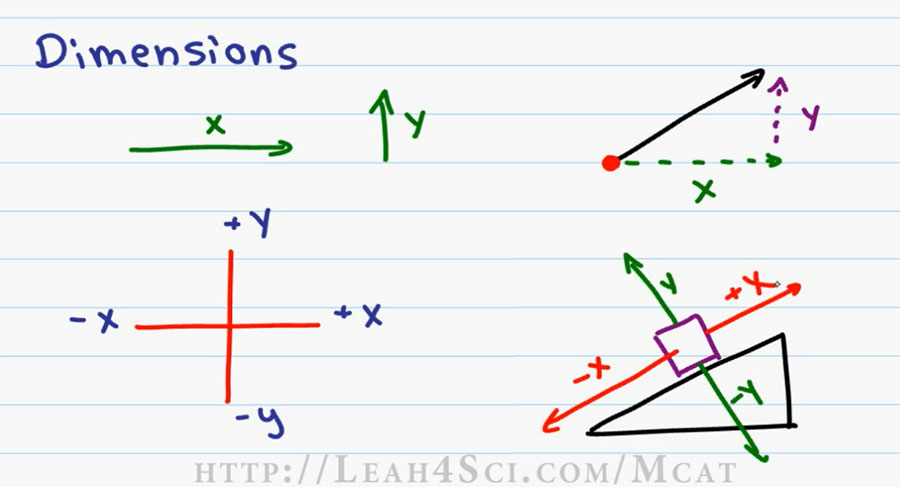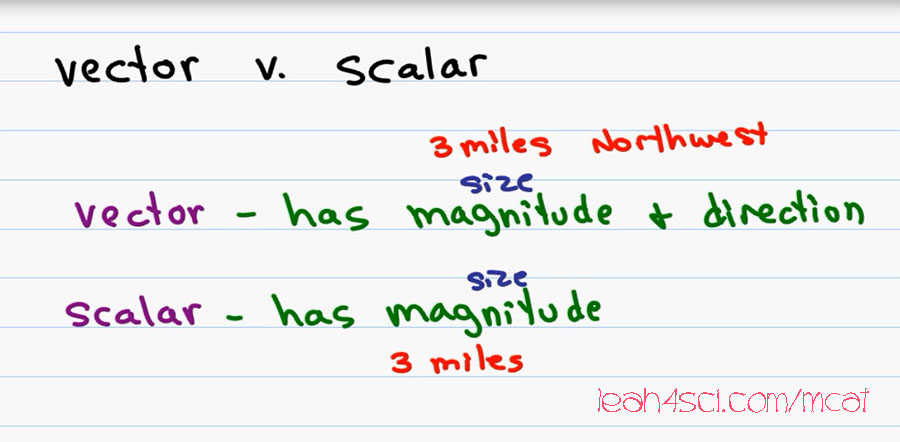 Below is the transcript of my tutorial video Introduction to Translational Motion – Dimensions, Vectors and Scalars
Below is the transcript of my tutorial video Introduction to Translational Motion – Dimensions, Vectors and Scalars
(Click here to watch on YouTube)
[Start Transcript]
Leah here from leah4sci.com/MCAT, and in this video we’ll start with discussion on Translational Motion with a quick introduction to dimensions, vectors and the concept of Kinematics. And before anything, oh this is too simple, let me jump ahead to the rest of the videos.
Take a moment, listen to what I have to say and make a promise to yourself that you will follow what I will tell you to do. You see the concept of dimensions, vectors and kinematics even though they tend to be more simple compared to the other MCAT topics, even though they tend to be simpler, these will serve as a foundation to how you study and everything that you learn.
So don’t just learn this information, make sure that you really understand what’s going on. You’re solid with the equations and most of all you know how to derive equation to equation and unit to unit because later on you will find yourself looking at formulas that have units equaling the kinematics for example you’ll see Force, you’ll see motion, you’ll see distance and you have to know how to go back and forth between them quickly.
You can find this entire series on my website at https://leah4sci.com/MCATPHYSICS.
In working with MCAT tutoring clients I often get a question on Dimensions so I wanna make sure you’re clear. When we’re talking about Dimensions, for the MCAT we’re only looking at one dimension or two dimension. If I have an object moving on a straight line, for example in the x direction or in the y direction, this object is said to be moving in just one dimension. It’s not that X is one and Y is two, x is one dimension, y is one dimension when they’re independent of each other.
However, if I have an objection moving in a direction that crosses both the x and y components as we can see with this Vector, we have a component of x direction, here we have another component in the Y direction. This object is said to be moving in two directions. If I have an object moving, it will be x, y and z direction. For example, the object here in addition to going slightly upwards, it is also coming out of the page or into the page, that is said to be moving in 3 dimensions. But on the MCAT you only have to know calculations for one and two dimensions so we won’t focus on the concept of the Z dimension.
The traditional way to set this up is positive x horizontal to the right, negative x horizontal to the left, positive y goes up, negative y goes down. But you don’t have to stick with this. You can take this dimension, rotate them and relabel any way you want as long as you’re consistent. In fact you probably seen problems where x and y are not as expected.

If you have an object on an inclined plane you’ve probably learn to set it up so the direction is negative x, the upward direction is positive x and then the positive y is perpendicular to the object up, negative y is perpendicular to the object down. We’ll discuss this in more detail when we’re talking about objects on an inclined plane but for now just recognize that as long as you have your x and y perpendicular to each other and your entry dimensions, you’re good to go.
Another important concept to know for this topic is the difference between the Vector and Scalar. If you look up on a dictionary you’ll see that a Vector is something that has magnitude and a direction and Scalar is something that has a magnitude.
But now let’s explain it in simple terms so that it’ll make sense and you can apply it to questions. A Vector has a magnitude which is simply a size but it also tells you which direction that thing is going. A Scalar only has size but it does not give you a direction. This can represent the same thing but the way you say it or write it will make a big difference.
So for example if I tell you that I went for a walk today and I walk 3 miles, great! I walk 3 miles in what direction? So 3 miles is the size, it’s the magnitude but I have no idea of the direction and therefore it is only a Scalar. If I tell you that I walked for 3 miles in a Northwest direction, I have a magnitude which is 3 miles, I have a direction, Northwest and that makes it a Vector.

On the MCAT you will be given a lot of numbers that are inherently Vectors but they may appear to be a Scalar so you can treat them the same way in larger numbers. For example if you’re calculating velocity, acceleration, motion in general, just recognize that the concept exists but we’re focusing on the Math and the bigger picture calculations.
Now that we have the basics, visit my site https://leah4sci.com/MCATPHYSICS, scroll down to the series on Translational Motion and that’s where we continue with Vectors and how to find their components. How to add Vectors and then we’re going to the Kinematic equations, velocity, acceleration and freefall.
This topic also requires a basic knowledge on how to do Math shortcuts because there will be a lot of calculation. You also have to be very confident with your Trigonometry and Sin, Cos values. If you’re not fully confident with this, go back to my MCATMATH series which you can find at https://leah4sci.com/MCATMATH , jump to the Trigonometry video and I show you the tricks and shortcut for quickly coming up with solutions so your time and energy can be invested in finding the answer rather than wasting time on tricky Math.
Are you stuck on a specific MCAT topic? I offer Private Online Tutoring where I focus on your needs to strengthen your individual weaknesses. Tutoring details can be found using the link below or by visiting my website leah4sci.com/MCATTutor.
Are you overwhelmed by the sheer volume of information required for the MCAT? Are you worried that lack of a proper study plan and low MCAT score will prevent you from getting into Medical School? My new ebook The MCAT Exam Strategy is 6-Week Guide to Crushing the MCAT will help you formulate a concrete study plan by helping you figure out where you stand now, identify your goals and figure out what it takes to reach them and it’s yours FREE when you sign up for my email newsletter at MCATExamStrategy.com. By signing up for my email newsletter, you’ll also be the first to know when I have new videos, MCAT Study Guide Cheat Sheets Tips and so much more! The link again MCATExamStrategy.com.
[End Transcript]
Watch The Video Here: Introduction to Translational Motion – Dimensions, Vectors and Scalars



Leave a Reply